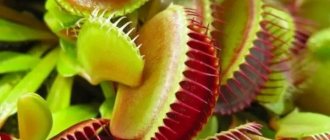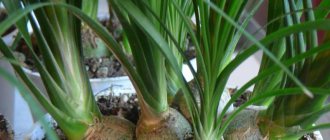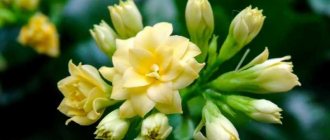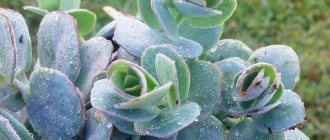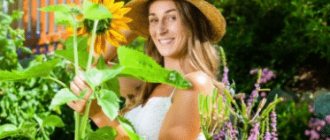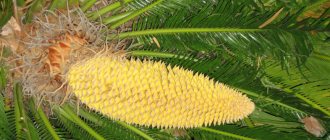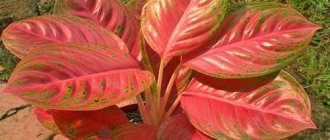Carnivorous plants! Strange name, isn't it? There are insectivorous birds, there are insectivorous animals - this is understandable. But is it possible to imagine a plant eating insects? Meanwhile, such representatives of the plant world exist, and there are even quite a lot of them: about five hundred different species. Protein food is also necessary for these plants, as it is for carnivorous animals.
The English naturalist Charles Darwin was the first to study in detail the life of insectivorous plants: in his works he showed how predator plants are structured, how they manage to catch their prey, how they digest protein foods, and also explained why these plants became carnivorous.
Pemphigus
Plants, which are given one common name - bladderworts, feed on the rotted remains of insects and other animals.
Bladderwort (Utricularia) is a large genus of insectivorous plants in the bladderwort family (Lentibulariaceae). Four species of the genus can be found almost throughout the entire territory of Russia, except for the regions of the Far North.
Bladderworts live in bodies of water - puddles, swamps and rivers. Their thin branching stems float on the water and, by the time of flowering, shoot out erect shoots, on the tops of which flowers bloom. The plant has no roots at all and is not attached to the bottom by anything.
The “hunting” of this plant is passive. Among the thread-like leaves of the bladderwort are many small pale green vesicles the size of a pea. Each bubble is a trap for small swimming creatures. The trap is intricately designed. At one end of the bubble there is a thin stalk (petiole) - with its help the bubble is held on the stem. At the other end there is a small opening, like a mouth, surrounded by hard, bristly hairs. The hole is covered with a valve, which swings back freely at the slightest external pressure, and then lowers again and locks the passage inside the bubble.
The bladderwort plant has chosen those places where there are a lot of small animals (mosquito larvae, various water worms, tiny crustaceans, fish that have just hatched from eggs).
All these small fry love to scurry among the stems of bladderwrack, not knowing for the time being that trouble is very close. Now the water flea pushed into the “door” of the bladderwort, and then the valve lifted and let the dear guest inside. Following this, the plant immediately closes the entrance to the trap, and the prey is caught. There is no way back for the insect: after all, the valve opens from the outside to the inside of the bubble, but it does not open from the inside to the outside. The prey dies and rots inside the traps, and its decomposed remains seep through the walls of the bubbles into the body of the bladderwort.
Water
They grow exclusively in bodies of water, where they feed on flying and excreting insects, as well as small crustaceans. As ornamental plants, they can only be found in specialized gardens, since it is extremely difficult to maintain optimal conditions.
Pemphigus
A numerous genus of carnivorous insects, more than 220 species have been described. They are found in fresh water bodies on almost all continents except Antarctica. Unlike other predatory flowers, bladderwort is characterized by rapid growth and development. It has the fastest trap among all carnivorous representatives of the flora.
The only insectivorous plant that uses a bubble trap. The principle of its operation is based on the difference in pressure with the environment. When a victim is nearby, the bubble sucks it in in a split second, closing the natural valve.
In most types of bladderwort, the trap is very shallow, where only the simplest microorganisms fall. Some species can also catch larger prey - tadpoles, water fleas.
Aldrovanda vesiculata
A monotypic genus of insectivorous plants of the Sundew family, lives only in fresh water bodies. The flower received its name in honor of the Italian Renaissance scientist. Found in lakes and rivers of Western Europe, Africa, Asia and Australia. Some researchers classify aldrovanda as a fossil plant species.
Outwardly, it is an inconspicuous perennial that is almost completely submerged in water. There are no roots, so the plant can move freely around the pond. Aldrovanda uses thread-like leaves as traps, reaching only 3 mm in length; the stems grow up to 11 cm.
They are characterized by a rapid growth rate, new dark green curls are formed every day. At the ends of the leaves there are sensitive bristles that respond to small aquatic larvae and crustaceans. When irritated, the leaves fold lengthwise, trapping the victim.
Darlingtonia californica
A predatory plant of the Sarracenia family, it grows wild in swamps and springs in northern California and Oregon. Named after an American doctor. It is protected by the state; today it is on the verge of extinction due to its very decorative appearance.
The leaves are bulbous in shape and form a kind of cavity with a small hole. They swell like a balloon, part of the leaf blade hangs down - in appearance it resembles a snake's fang.
Darlingtonia uses a trap similar to a crab claw, and the bait is rays of light that actively attract insects. As a result, the victim lands on numerous hairs growing inside the plant and cannot get out of it. Darlingtonia has an attractive appearance, so it can often be found as a decorative flower in a greenhouse. It is very difficult to grow it at home.
Sarracenia
In the swamps of North America there grows a plant that scientists have dubbed the name “sarracenia”.
Sarracenia is a genus of plants in the Sarracenia family. Today there are 10 species, as well as several subspecies and about 100 varieties created by breeders.
This plant has very interesting leaves; With their help, Sarracenia hunts.
Each leaf looks like a bag or jug, narrowed at the top and bottom and swollen in the middle. At the hole that leads into the jug, protrudes a green leaf blade with burgundy-colored veins, reminiscent of a shell. It collects raindrops. From this vessel, rainwater penetrates into the bag and fills it approximately 1/2. There is always at least a little water in the bag, even in drought. Sarracenia leaves serve as trapping pits (or trapping pitchers) for insects - both winged and wingless.
Almost all types of sarracenia have brightly colored leaves. From a distance it’s like flowers—beautiful and elegant. Insects are captivated by this beauty, and this is so beneficial for the plant. The lower half of the leaf is bright green. At the bell it is light green and covered with a network of red veins. The dome looks especially colorful; here the leaf wall is very thin, almost transparent and completely decorated with veins. Well, how can you not covet such beauty?
Noticing sarracenia leaves from afar, insects approach them in the hope of eating something tasty. Their hopes are not in vain - the leaves have an excellent bait: inside the trapping jugs, at the very entrance, there are nectar-bearing glands. Looking into the middle of the leaf, the insect sinks deeper and deeper until it drowns in the liquid filling the jug. The drowned man rots, decomposes, and its rotten remains are absorbed by the walls of the sarracenia leaf. In its trapping pitchers you can find many small insects, and sometimes even frogs and rodents.
This exotic plant is also suitable for home keeping. In summer, it can be taken out to the balcony, where it will independently obtain food for itself, and in winter, it can be given food for fish.
Insectivores
These predatory plants feed exclusively on arthropods; when meat or shellfish are ingested, an active process of rotting begins. For this purpose, they use a variety of traps, in which a special enzyme is abundantly released, attracting and digesting prey. The largest group of carnivorous plants, some of which grow in Russia.
Sundew
A large genus of carnivorous plants, numbering more than 190 species. They live on almost all continents, preferring swampy and poor soils. In one place, sundews can live for more than 50 years, forming basal or vertical rosettes with an attractive appearance. It is actively cultivated as a home potted flower, which is distinguished by its whimsical care and cultivation.
The trap of all sundews is represented by moving tentacles, the small hairs of which are abundantly moistened with a sticky enzyme - this is what attracts small insects (see photo). As soon as the prey lands on the plant, the edges of the leaves begin to curl, wrapping around it. On average, digestion lasts 1-2 days, after which the trap opens again.
Zhiryanka
A genus of perennial insectivorous plants, found in non-tropical regions of the Northern Hemisphere and Asia. More than 80 species have been described, some of which are on the verge of extinction. It has large leaves of bright green or pink color, abundantly covered with a layer of sticky fat. The plant produces two types of cells responsible for the process of producing an enzyme for processing the victim and secreting mucus.
The butterwort feeds exclusively on small insects, less often on arachnids. Most species enter a dormant stage in winter, when hunting stops completely. The leaves look extremely decorative, which is why the plant is widely grown today as an exotic potted flower.
Sarracenia
This flower grows wild in North America and Canada. Prefers moist, marshy soils and often grows near bodies of water. The plant received its name in honor of the Canadian biologist M. Sarrazin; today more than 500 species have been described.
The trap is represented by funnel-shaped leaves in the shape of a red-green water lily. There is a small hood on top that protects the flower from rainwater getting inside. The trap produces a secretion that emits an odor that attracts small insects. After entering the water lily, the victim is digested within several days.
Venus flytrap
The most famous carnivorous plant, actively used as a decorative house flower. In its natural environment, it is found in marshy areas of the United States, where it is considered an endangered species. The Venus flytrap was described by Charles Darwin, who was surprised by the speed of the trap - it is only 0.1-0.3 seconds. It is she who is most often depicted in pictures in textbooks and manuals in the section devoted to carnivorous plants.
The leaves form two large lobes, inside colored red or green depending on the variety. Along the edges of the trap there are small processes that secrete mucus - it is this that attracts small insects and spiders. Inside it there are very sensitive villi, which give a signal for the leaf plate to slam shut when the victim gets inside. One trap can eat up to 3-4 insects, after which it dies.
Cephalotus saccularis
A small genus of evergreen insectivorous plants. It is found only in Australia and Albania, where it is under state protection. In the reports of biologists, the beginning of the life of this flower dates back to the Stone Age. It is rarely used as an ornamental potted plant due to the difficulty of care.
Cephalotus is a small flower, reaching a height of only 5 cm. The trap is represented by a soft water lily, the jagged edges of which are very decorative. They develop only in summer; throughout the rest of the year, traditional flat leaf blades are formed.
The top of the water lily is covered with a small lid, which constantly protects the trap from water and dew. It mainly feeds on small flying insects; digestion takes several days.
Nepenthes
The plants that were considered (sarracenia, bladderwort) feed on the corpses of small animals, i.e. they eat, so to speak, carrion. They do not produce their own “stomach juice”, unlike plants, which we will talk about later.
So, it’s like a ladle in front of you, but it’s also a leaf. Its petiole is swollen at the end in the shape of a ladle, its edges are densely lined with sharp teeth, which face the inside of the ladle, and above them is a lid (leaf plate). The plant on which such strange leaves hang is called “nepenthes” (or pitcher plant).
Nepenthes is a genus of carnivorous plants of the monotypic family Nepenthaceae.
In total, 7 species of Nepenthes are known in the world. They come from hot countries.
Nepenthes do not grow very well in greenhouses and rarely produce large leaves. But in natural conditions, in their native lands, they form simply huge leaves. For example, on the island of Borneo, in the forest, there are Nepenthes with pitchers more than 45 cm long, and the hole leading into such a huge leaf is 13 cm or more in diameter. They say that a pigeon that wanted to fly into such a pitcher could freely I would like to hide in it.
As you probably already guessed, the pitcher leaf of Nepenthes is a trap for all kinds of insects, both large and small, both winged and wingless. If you look into one of the jugs, at the bottom you can find a whole bunch of insects, dead and still alive.
As we have already said, in the tubular leaves of sarracenia and in the vesicles of the bladderwort, insects rot, decompose, and the liquid obtained from their corpses gradually passes into the body of the sarracenia and bladderwort. For Nepenthes, everything is different: once the insect gets into the plant’s jar, it is digested. At the bottom of each Nepenthes jug there is a special sour liquid. It then digests the insects that have climbed into the jug in much the same way as the gastric juice secreted by the walls of our stomach digests pieces of meat.
As you know, there are many birds that feed on insects. Having learned that rich prey can be found in the pitcher leaves, insectivorous birds climb inside the pitchers and drag insects from there.
How do carnivorous plants differ from ordinary plants?
The development and growth of ordinary plants occurs due to autotrophic metabolism. The chemical elements contained in their leaves, obtained from soil, air and water, are converted into nutritious organic compounds under the influence of ultraviolet rays.
How do predators feed?
But not all plants are lucky enough to grow in fertile soil rich in all the necessary elements. To survive, they had to adapt to their living conditions and look for other sources of food.
Plants-predators are such “opportunists”. In nature, they usually grow in sand, water, marshy and poor soils, and some even attach themselves to larger plants. They obtain the minerals necessary for life by “eating” small living organisms and thereby compensating for the deficiency of nitrogen, potassium, phosphorus and other important microelements.
Among them there are large bushy plants and herbaceous perennials. Almost all of them are incredibly beautiful and very unusual in appearance.
Darlingtonia or Cobra Lily
Lusitanian rosewort
Pemphigus
Heliamphora
Byblis
Rafflesia
On a note. The fact that “predators” feed on living organisms does not negate the processes of photosynthesis inherent in all plants. They also need light, nutrition, and water. After all, hunting is not always successful.
Types of insect traps
There are several mechanisms for catching insects inherent in predator plants. Everyone has their own.
- Active catchers include flycatchers and sundews, which capture insects;
- Passive traps are designed in such a way that living organisms themselves fall into the trap. For example, they roll down the downward slippery hairs into a funnel filled with water, like a heliamphora;
- Some carnivorous plants, such as butterwort, secrete sticky substances, in which insects become stuck and are doomed to death;
- There are plants with real traps in the form of bubbles or slamming vessels (nepenthes, bladderwort).
Trap leaves are also the digestive organ of these predators. They secrete substances that break down and digest organic matter.
It is no longer possible to escape from sweet captivity
But in order to catch an insect, it must be attracted to you. The bright colors of the plants and seductive aroma serve this purpose. He can be either very pleasant or bad. After all, not all insects feed on nectar; some prefer carrion and rotting waste.
Rosolist
Roseleaf (Drosophyllum lusitanicum) is a very interesting small plant that grows in sandy or even rocky soils in Portugal and Morocco. Its long leaves - like braid - are crowded at the base of the stem, at the top of which several large flowers usually bloom. The whole plant seems to be covered with drops of dew. Hence its name. In fact, this is not dew at all, but small droplets of sticky thick mucus, which serve to catch insects.
As soon as some mosquito, ant or bug lands on a dew leaf, the insect’s entire body immediately becomes covered with drops of sticky liquid - and then it can no longer escape. Then another juice secreted by the leaves comes to the aid of the glue. It digests all the soft parts of the insect’s body.
Sundew
The dew leaf plant should not be confused with another plant that grows in Russia, in swamps, and also here and there along the banks of streams. It's called sundew.
Sundew (Drosera) is a small plant with leaves that are clustered at the base of the flower stalk, similar to those of the dew leaf. However, unlike the latter, its leaves look more like spatulas.
Looking at a sundew, the first thing you notice is that each leaf is lined with long pink hairs (eyelashes) on top and on the edges. The tips of the eyelashes are thickened and covered with drops of shiny juice. Small insects mistake this juice for honey and willingly land on the leaves of the predator plant in the hope of feasting on the honey.
A fly flew in and carefully landed on the leaf, but caution did not help: it touched the hairs with its paws and smeared itself with sticky juice. The fly tries to correct the mistake and sneak away, but that was not the case. The more it rushes about on the surface of the leaf, the more often it touches the hairs, the more juice they secrete. With every movement of the fly, retreat becomes more and more difficult. Finally, exhausted by fruitless attempts to escape, completely smeared with sticky juice, as if tied hand and foot, she resigns herself to her bitter fate and no longer fights. And then the sundew’s hairs begin to bend over the victim’s body one after another, attach their heads to it and pour juice over it. This is their purpose, that’s why they stick out on the leaves of the predator. The juice digests all the soft parts of the fly, and when, a few hours later, the eyelashes rise again, there is practically nothing left of the fly.
So, the sensitive hairs of the sundew are able to move when necessary.
Domesticated predators
Not all carnivorous plants take root at home. The easiest ones to grow are those that are accustomed to a warm-temperate climate.
These include:
- Fine-leaved sundew is more often grown at home than other such plants. Whereas in the wild it is already very rare and is even listed in the Red Book. Sundew leaves, located on thin red stems, are covered with glandular hairs. They are coated with a sweet liquid that looks like shiny dewdrops and emits a strong aroma to attract insects. As soon as they land on the plant, the hairs begin to move and entangle the victim, preventing it from resisting. After which the leaf slowly curls into a tube, and enzymes necessary for digesting food begin to be released inside it. This process continues for several days.
Sundew fine-leaved
Note. With proper care, sundews can bloom with white, yellow or pink flowers in July and August.
- Cape sundew is the most attractive variety of this species. Thin and elongated leaves covered with hairs grow from the root on delicate stalks. It blooms for a long time with numerous, gradually opening flowers. Reacts by grasping and folding the leaf only to organic food. It has the ability to digest even the cartilage and bones of small animals. After the digestion process is completed, the folded leaf opens again.
Cape sundew
On a note. The mechanism for capturing and digesting each leaf is designed for 3-4 times. After which it dies.
- The Venus flytrap got its name in honor of Venus, the goddess of love, for the external resemblance of its leaves to the female genital organs. They are two oval-shaped valves with tooth-like processes along the edges. The inside of the valves is covered with hairs. They react sensitively to an insect sitting on a leaf, causing the doors to instantly slam shut. After which special glands that secrete enzymes are activated. Depending on the size and type of the victim, it can take from one to three weeks to digest. Then the valves open again, and the undigested remains of the insect are carried away by the wind or washed away by rain.
Venus flytrap
Victim in a trap
In late spring - early summer, the flycatcher blooms with beautiful white flowers on a long peduncle
- Sarracenia not only behaves, but also looks unusual. Looking like flowers twisted into a funnel, the leaves grow directly from the roots. At the top, the trap funnel expands and forms a kind of lid. The leaves can have very different colors depending on the variety. Therefore, when sarracenia blooms with purple or red flowers, it looks even more unusual - as if two different plants are growing in a pot.
Sarracenia in nature
The graceful shape of the leaves resembles flowers
Sarracenia flower
- Pemphigus humpback is an aquarium nurse plant that purifies water from microorganisms and small suspended matter. Long stems with many narrow alternate leaves have no roots. The trap bubbles located on the petioles are filled with air. Microorganisms enter through a small opening framed by slippery hairs and covered with a valve. These same bubbles hold the plant on the surface of the water.
Bladderwort in the aquarium
Bubble Trap
Flowering plant
Note. Growing strongly, bladderwort can attach to other plants and entangle aquarium decorations.
- Zhiryanka , unlike many other predators, looks simple, outwardly no different from ordinary indoor flowers. Its catching mechanism is based on the adhesion of small insects to the leaves, which secrete a sweet liquid. But they do not curl up like sundew leaves, but simply begin to immediately produce digestive juice.
Zhiryanka
- Nepenthes lures its victims into a trap in the form of small jugs with slippery walls, inside of which digestive enzymes are produced. In the wild, these vine plants reach several meters in length, and the brightly colored pitchers can be up to half a meter deep. They often trap not only insects, but also small animals - rodents, amphibians, birds.
Nepenthes at home
Trap with a victim
Some specimens reach gigantic sizes
This is interesting. Almost all carnivorous plants have flowers with long peduncles. They are necessary for maximum removal of flowers from traps - insects responsible for pollination should not get into them.
Growing and care
Carnivorous plants require slightly different conditions than indoor flowers. First of all, this is a humid environment, so it is best to keep them in florariums or aquariums, or by placing the pots on trays with acidified water.
The soil should not be allowed to dry out. As well as keeping them near heating devices.
Venus flytrap in the florarium
Growing rules must meet the following conditions:
- Acidic nutrient medium. In nature, predators grow mainly in poor and acidic soils, so it is best to plant them in a mixture of peat, river sand, vermiculite and moss.
Note! There is no need to feed these plants in the traditional way! To feel normal, it is enough for them to “eat” 2-3 flies per month. If there is no “live food” in the apartment, special liquid fertilizers are regularly sprayed on the leaves.
Blackening and falling leaves indicate a lack of nutrition.
- Long daylight hours. Such plants are very demanding of light. All of them (with the exception of the Venus flytrap) do not like direct sunlight, but the illumination must be sufficient and long-lasting. To create optimal conditions, you will have to use phytolamps or fluorescent lamps.
Homemade growbox for carnivorous plants with lighting
- The air temperature in summer should not rise above +30 degrees. In winter, plants hibernate; during this period they need to create cool conditions and reduce watering.
- It is best to plant predators in a plastic or glass container. Clay pots are absolutely not suitable as they release harmful salts.
The best planting container is a regular plastic pot with drainage holes.
- The best foods for carnivorous plants are house flies, fruit flies and spiders. They should not be fed mealworms due to their high calcium content.
flycatcher
The leaves of another insectivorous plant also have the ability to move. We will talk about the famous Venus flytrap or Dionaea muscipula.
Its leaves with thorns, capable of folding in half, are real insect traps. As soon as any insect sits on a leaf, its halves immediately slam shut and open again only when all the soft parts of the caught prey are digested and absorbed by the leaf. The flycatcher grows in the swamps of North America.
Venus flytrap: description and photo
The Venus flytrap (Dionaea muscipula) grows naturally in the swamps of the east coast of North America. Species from the monotypic genus Dionea of the Sundew family (Droseracea).
This is interesting: The scientific species name is translated from Latin as “mousetrap” - muscipula. The natural diet of the Venus flytrap consists of one third ants, one third spiders, 1/10 beetles and 1/10 grasshoppers, and a few flying insects
The plant is a small herbaceous plant. A rosette of 4-7 leaves, up to 15-20 cm high. Real ordinary leaves are small, trap leaves are formed after flowering.
Venus flytrap blooming
How does a Venus flytrap catch insects?
The Venus flytrap catches insects and arachnids using leaves transformed into a special trapping apparatus. On the surface of the leaves there are special sensitive hairs, when irritated, the trap slams shut. When open, the lobes of the trap are convex (curved outward); after closing, the lobes bend, forming a cavity inside, the exit from which is closed by hairs.
In order for the trap leaf to close, it is necessary to irritate at least 2 hairs with an interval of no more than 20 seconds. This protects the flytrap from accidental “triggering of the trap” - closing the leaves from dirt or droplets of water.
Digestion begins at least after 5-fold stimulation of the sensitive hairs.
Why did plants become predators?
Surprisingly, it is a fact that not only predatory animals live on our planet, but also predatory plants. Why did they become like this?
Remember on what soil these representatives of the plant world live. Some are in swamps, others are among stones or sand. How many nutrients can a plant get from swampy or sandy soil with the help of its roots? Of course no. And so, forced to live in such harsh conditions, plants learned to catch insects and eat their meat. As we see, under the pressure of need, a special breed of carnivores appears, i.e. meat-eating plants. At the same time, some of them feed on carrion, while others lure live prey and digest it with the help of juices, greedily absorbing the digested food. These latter, such as Nepenthes, sundew and flycatcher, can, if necessary, eat pieces of meat and hard-boiled eggs.
If you put a piece of egg or beef on a flytrap leaf, the halves of the leaf will immediately slam shut, then a liquid will begin to be released from the leaf, which will digest both the meat and the egg. When the food is digested, the leaf will absorb it.
However, it is worth noting that when growing a flycatcher at home, you should not experiment and feed it with meat, eggs and other human food - this can destroy it. Usually, in an apartment, she is able to get her own food. But if flies and mosquitoes do not come to you, then you will have to feed her - 2 times a month, offer her live insects - flies, spiders, slugs.
Omnivores
These are rare large plants that can feed not only on insects, but also on mollusks, as well as small animals and birds. Usually grow in the tropics, they are practically never found as decorative flowers. They have a very beautiful appearance, for which they are valued by lovers of exotic plants.
Nepenthes (Pitcher plant)
A tropical carnivorous plant, found growing wild in China, India, the Philippines and Madagascar. More than 130 species are known; among local residents, Nepenthes is known as the “monkey bowl”, as these animals drink water from it.
Almost all species are represented by vines reaching 15 m in length. Despite this, the root system is very weak and often cannot withstand powerful winds. Tendrils form on the stem, at the end of which a large cup-shaped water lily forms. It is this that is the trap. Inside there is a sticky liquid where insects drown in large numbers.
At the bottom of the bowl, enzymes necessary for the digestion process are released. Large species can easily catch and digest small rodents, in particular rats.
Byblis
A genus of carnivorous plants that grows wild in northern Australia and southern New Guinea. Inhabits swampy and heavily moist soils. Because of its attractive appearance, it is often called the “rainbow plant.” Until now, researchers have not figured out the nature of insect digestion, since the flower does not secrete the enzymes necessary for this process.
Externally, Byblis is represented by a shrub growing up to 70 cm in height. During the growing season, beautiful flowers are formed, colored purple or white. The type of trap is similar to the sundew - these are leaves that lure the victim and then curl. Due to the large growth area and the very sticky composition of the bait, small birds and rodents often get into the plant.
Carnivorous plants are the real pride of any gardener. They are extremely demanding for home cultivation, but have an interesting appearance and decorative value. Due to their structural features, throughout the year they are able to catch insects that they need for growth and development. When choosing a type of carnivorous flower, you need to carefully study the characteristics of its maintenance in order to avoid its rapid death at home.
